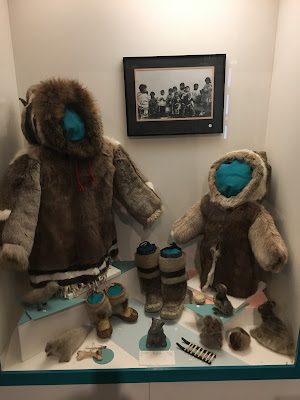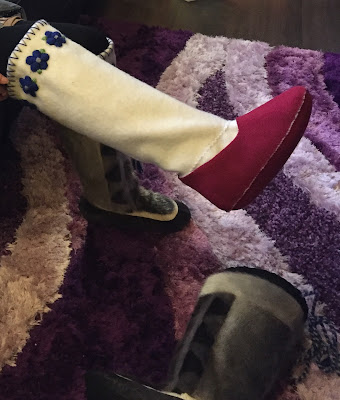Having guests while up here comes with its own set of unique considerations. First, if your guests are first-timers to the north, you need to be upfront with them as to what to expect. A key question to ask when someone says they want to visit:
Next, let your potential guests know what they are in for. For instance, there is NOTHING to do here in January. Its dark, and its cold. All the time. Not just "wear your heavy winter coat that you wear in Toronto", but bone-chilling "never feel warm again" cold. As in, think about buying a parka that was designed to be worn in the arctic. Ditch the cute knitted mittens and scarves.
 |
| That is a windchill of -50 on Thursday, folks. |
 |
| Your arctic guest room awaits. |
When nice, considerate guests fly up (and we have only ever had nice, considerate guests), they will ask you what they can bring. I'm lucky that most of our family and friends follow the blog, so they know what a struggle it can be to get specific items up here. The last time my mother came up she brought bread crumbs and wine (among other things). Coraline's coach brought gift wrap and craft supplies for the kids. There's a fine line between sending down the list of things you REALLY wish people could bring (an aesthetician. McDonald's hamburgers. Mexican food. Anthropologie.) and what they can realistically bring, so you need to prioritize.
Mylo (feline love of my life) somehow managed to swallow enough of something last year that he nearly died. We think it may have been stuffing from a stuffed animal, but we're still not sure. Whatever it was, it was blocking his intestines, so he was unable to keep food and water down. After a week of weight loss, dehydration, and projectile vomiting, he had to have surgery to clear the blockage. Since then, he needs to be on a special diet of easily digestible food. I was told by the local vet this wouldn't be a problem, that I could order the food and it would be shipped every 6 weeks. I brought enough to last several months, just to be safe. Silly me. We're on "island time", remember? The first food order took 3 months to arrive, and then was the wrong food. The second order (3 months later) has not come in yet.
Our latests guests, Edmund and his son Wallis, were kind enough to bring us up cat food.
 |
| So tell me what you want, what you really, really want-- I'll tell you what I want, what I really want... |
What do you do when your guests finally arrive? You treat them to a nice, warm, arctic meal: caribou stew! One of Coraline's friends surprised us last week when she showed up on the doorstep with meat. She had brought us a huge chuck of caribou (tuktu) and an arctic char--a gift from her parents. I put the char in the freezer to save for when my mother comes up again, but decided to serve the caribou when our guests arrive. I have never cooked caribou before, so I figured the simplest thing to do would be to cook it in a stew the same way I would with beef. After all, its just like beef, right?
Not quite. Bear with me while I go off on a tangent.
A few Inuit hunters were at the convenience store one morning getting ready to head out onto the land (I just happened to be there at the same time). I took note of one man in particular--he was wearing a sealskin parka, sealskin pants, and a pang hat, with a rifle slung over his back. He looked like he had just stepped off the cover of National Geographic magazine. I was content to admire this scene from afar: a group of hunters around their snowmobiles, laughing and joking in -30 degrees, getting ready to go hunting on the tundra. Lucky for you blog readers, my mother was with me. She saw what I saw, and immediately jumped out of the car clutching her camera. "Oh no," I thought, head in my hands, "This is so embarrassing. These people are just going about their lives, they are not on display at a museum..." My mother, who has none of my reservations about approaching strangers, walked into the middle of the group and said "Would you mind if I took your picture?" The hunter graciously agreed. He even struck poses.
 |
| Inuit hunter about to go out onto the land. |
 |
| Close-up of the rifle |
 |
| Actual cover of National Geographic. (source) |
I really need to worry less about insulting people and intruding on their lives. Apparently, at least when my mother does it, they don't mind at all. After we took pics of the hunter in traditional clothing, one of his buddies jumped forward.
 |
| "Hey, whadda bout me? Want my picture? Grrrr..." |
I am not a butcher, nor am I a hunter. From what I have been told, normally an animal (or is it just the meat?) is drained of blood prior to the meat being chopped up and frozen. Caribou is hunted on the frozen tundra, so when the animal is killed, it freezes on the spot. The frozen carcass is dragged back to town, skinned, then sawed into pieces while still frozen. Then its given out to various families known to the hunter, and whatever is left over is posted for sale on Facebook. When I thawed this caribou meat, it was BLOODY. We're not talking that little bit of watered-down reddish/pinkish stuff that comes out of your average package of steak or ground beef. We're talking the kitchen sink looked a bit like a slaughter house.
From this....
to this......
 |
| The caribou meat we were gifted with. |
 |
| Ahhh.....caribou stew and vino. |
You might be wondering if there is any big difference to cooking with caribou vs. beef. I didn't expect there would be, but I was wrong. Caribou is.....for lack of a better word....squishy. Its much softer than beef, at least when raw. There also isn't much marble in the meat. My knife sliced through it like butter. It can be tough to cut the sinewy stuff off, just because the meat is so spongey. To show the contrast check out the photos below.
BTW: generally people said they really couldn't taste a huge difference between the beef stew (which I made as a back-up for those who weren't adventurous enough for caribou) and the caribou. The texture was slightly different.
 |
| This is typical stewing beef. There is a fair amount of white fat visible, and the pieces are firm. |
 |
| This is the caribou meat. Very dark, very little white fat, and nowhere near as firm. |
 |
| This photo just shows the contrast again. |
So, your guests arrive bearing food/sundries. You have fed them. Now what do you do with them? See my point above: there is NOTHING to do. That is sort of true, but its not totally true. There is a visitor's centre, a museum, the Frobisher Racquet Club, and a territorial park.
Our guests are only here for a few days, so we did our best to cram in as much of an "Iqaluit experience" as we could. The first day we started off with the museum. The Nunatta Sunakkutaangit Museum is known as the best place in town to purchase carvings, jewelry, and other artwork (aside from the craft shows, and possibly the prison). The reason for this is because the museum supports local artists: markup is minimal so the prices are reasonable. Also, they only sell high quality stuff.
 |
| Nunatta Sanukkatuaangit Museum |
 |
| Display cases with stone carvings, jewelry, and other art. |
 |
| Stone carvings of polar bears and other animals are hot sellers. |
 |
| Amauti. If you missed the post about these click here. |
Up next: our journey with our guests continues as we head to the visitor's centre, the territorial park, Yummy Shawarma, and celebrate a birthday at the racquet club. Tune in next time to catch up!

























































